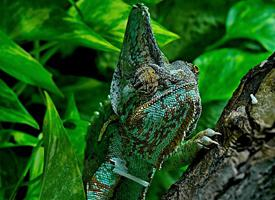
Weights and measures
| Length | from 26 to 28 cm |
|---|
Biological data
| Lifespan | 6 r |
|---|
State of endangerment
| Endangered |
Animal description
The Crested Chameleon, scientifically known as Trioceros cristatus, is a fascinating and unique species of chameleon native to the rainforests of West and Central Africa. This species is particularly known for its distinctive physical appearance and adaptive behaviors that make it a remarkable example of evolutionary adaptation.One of the most striking features of the Crested Chameleon is its namesake crest. This is a ridge of small, triangular scales that runs along the dorsal spine of the animal, starting from the back of its head and extending down to its tail. This crest, which can vary in prominence among individuals, serves not only as a key identifying feature but also potentially plays a role in thermoregulation and mating displays.
The coloration of Trioceros cristatus is typically a vibrant mix of greens, browns, and sometimes yellows, allowing it to blend seamlessly into its lush rainforest surroundings. Like other chameleons, it possesses the remarkable ability to change its skin color. This color change is not just for camouflage but is also used to communicate with other chameleons and to regulate its body temperature.
Crested Chameleons have a zygodactylous foot structure, meaning they have two toes pointing forward and two pointing backward on each foot, a feature that provides them with a strong grip on branches and vines. This adaptation, combined with their prehensile tail, makes them excellent climbers, capable of navigating the complex vertical spaces of their arboreal habitat with ease.
The eyes of the Crested Chameleon are another fascinating aspect of its biology. They can move independently of each other, allowing the chameleon to look in two different directions at once. This panoramic vision is crucial for spotting predators and prey in the dense foliage. When a target is identified, the chameleon can focus both eyes in the same direction, giving it precise depth perception to accurately judge the distance to its prey.
Crested Chameleons are insectivorous, primarily feeding on a diet of insects and occasionally small vertebrates. They employ a unique hunting strategy, remaining almost motionless and blending into their surroundings until an unsuspecting prey comes within range. Then, with lightning-fast accuracy, they project their long, sticky tongues to capture the prey, pulling it back into their mouths.
The reproductive habits of Trioceros cristatus involve the female laying eggs, which she buries in moist soil or leaf litter. The eggs undergo a period of incubation that can vary in length, depending on environmental conditions, before the young chameleons hatch, fully formed and independent.
Despite its fascinating biology, the Crested Chameleon faces threats from habitat destruction and the pet trade. Deforestation and the conversion of land for agriculture are reducing its natural habitat, while capture for the exotic pet market puts additional pressure on wild populations.
In conclusion, the Crested Chameleon is a remarkable creature, embodying the incredible adaptability and diversity of life. Its distinctive physical characteristics, behaviors, and ecological role make it a subject of great interest for biologists and conservationists alike, highlighting the importance of preserving the rich biodiversity of our planet.
Similar Animals
New photos of animals
Top 10 animals
- Dolphin gull (Leucophaeus scoresbii)
- Diana monkey (Cercopithecus diana)
- Moustached guenon (Cercopithecus cephus)
- Galápagos tortoise (Geochelone nigra complex)
- Japanese macaque (Macaca fuscata)
- Stone loach (Barbatula barbatula)
- Russian tortoise (Testudo horsfieldii)
- Greek tortoise (Testudo graeca)
- Common flying dragon (Draco volans)
- Vendace (Coregonus albula)


